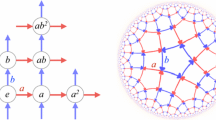Abstract
Methods developed in a previous paper are employed to define an exact correspondence between the states of a deterministic cellular automaton in 1+1 dimensions and those of a bosonic quantum field theory. The result may be used to argue that quantum field theories may be much closer related to deterministic automata than what is usually thought possible.
Similar content being viewed by others
Notes
Indeed, this part of the identification is valid in many more cellular automaton models that can be identified with quantum field theories, also in higher dimensions; it is the next part of the argument however, that we do not know exactly how to generalize.
The function r(η,ξ) here differs by a factor \(\epsilon^{-\frac{1}{2} \xi^{2}}\) from the function used in Ref. [4].
References
’t Hooft, G.: Quantization of discrete deterministic theories by Hilbert space extension. Nucl. Phys. B 342, 471 (1990)
’t Hooft, G., Isler, K., Kalitzin, S.: Quantum field theoretic behavior of a deterministic cellular automaton. Nucl. Phys. B 386, 495 (1992)
’t Hooft, G.: Quantummechanical behaviour in a deterministic model. Found. Phys. Lett. 10, 105 (1997). quant-ph/9612018
’t Hooft, G.: Relating the quantum mechanics of discrete systems to standard canonical quantum mechanics. ITP-UU-12/14. SPIN-12/12. Found. Phys. (to be published). arXiv:1204.4926
Bell, J.S.: On the Einstein Podolsky Rosen paradox. Physica 1, 195 (1964)
Einstein, A., Podolsky, B., Rosen, N.: Can Quantum mechanical description of physical reality be considered complete? Phys. Rev. 47, 777 (1935)
Jammer, M.: The conceptual Development of Quantum Mechanics. McGraw-Hill, New York (1966)
Aspect, A., Dalibard, J., Roger, G.: Experimental test of Bell’s inequalities using time-varying analyzers. Phys. Rev. Lett. (1982). doi:10.1103/PhysRevLett.49.1804
Goldstone, J.: Field theories with superconductor solutions. Nuovo Cimento 19, 154 (1961)
Nambu, Y., Jona-Lasinio, G.: Dynamical model of elementary particles based on an analogy with superconductivity. I. Phys. Rev. 122, 345 (1961)
Coleman, S.R.: There are no Goldstone bosons in two dimensions. Commun. Math. Phys. 31, 259 (1973)
Gradshteyn, I.S., Ryzhik, I.M.: Table of integrals, series, and products. Jeffrey, A., Zwillinger, D. (eds.). ISBN 0-12-294757-6. See also Dieckmann, A: http://pi.physik.uni-bonn.de/~dieckman/InfProd/InfProd.html
Sagle, A.A., Walde, R.E.: Introduction to Lie groups and Lie algebras, vol. 49, p. 25. Academic Press, New York (1973). See also Phys. Rev. Lett. 49(25), 1804 (1982). doi:10.1103/PhysRevLett.49.1804
’t Hooft, G.: How a wave function can collapse without violating Schrödinger’s equation, and how to understand Born’s rule. ITP-UU-11/43. SPIN-11/34. arXiv:1112.1811 [quant-ph]
Klebanov, I., Susskind, L.: Continuum strings from discrete field theories. Nucl. Phys. B 309, 175 (1988)
’t Hooft, G.: Discreteness and determinism in superstrings. ITP-UU-12/25. SPIN-12/23. arXiv:1207.3612 [hep-th]
Author information
Authors and Affiliations
Corresponding author
Appendix A: Left and Right Movers
Appendix A: Left and Right Movers
The cellular automaton as well as the quantized field theory will be postulated to obey the same equations on the lattice. In both systems, we locate the field variables q(x,t) on the regular lattice sites (x,t) where both x and t are restricted to be integers. The momentum variables are located conveniently on half-odd time coordinates, but sometimes it will be more practical to locate them on integer spots. Therefore, we write

While in the quantized field theory these variables are operators with a continuous spectrum of eigenvalues, obeying the usual commutation rules (4.1), the cellular automaton is described by replacing q(x,t)→Q(x,t) and p(x,t)→P(x,t), where Q and P only take integer values and all commute. In this Appendix we keep the notation q and p.
The evolution equations are Eqs. (4.15) and (4.16). It is sometimes useful to have the complete solution of these equations forward in time:


The q and p fields can be split up in left-movers and right-movers:

which obey the equations

However, we will often consider the more fundamental left and right movers a L, a R, defined by inverting (A.4):


It is easy to verify from the basic equations (4.15) and (4.16) that the rhs of (A.6) and (A.7) will roll to the left and to the right, respectively. In momentum space, a L and a R will be associated to the particle creation and annihilation operators of the field theory.
Assuming the commutation relations (4.1), the operators a L and a R will obey easy commutation rules themselves, as given in Eqs. (4.4) and (4.5), while the commutation rules for q L, q R, p L and p R will be non-local. This is why it would be difficult to introduce interactions that are expressed directly in terms of the q(x) and p +(x) operators.
Rights and permissions
About this article
Cite this article
’t Hooft, G. Duality Between a Deterministic Cellular Automaton and a Bosonic Quantum Field Theory in 1+1 Dimensions. Found Phys 43, 597–614 (2013). https://doi.org/10.1007/s10701-013-9702-z
Received:
Accepted:
Published:
Issue Date:
DOI: https://doi.org/10.1007/s10701-013-9702-z




